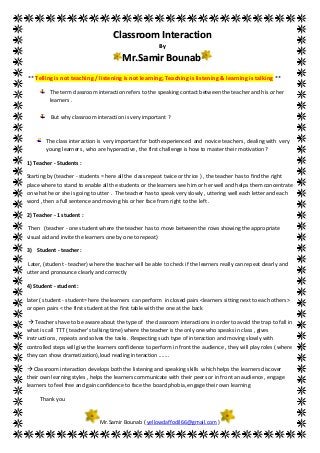classroom interaction.pdf
•
0 likes•66 views
How important to know and master the classroom interaction for better learning
Report
Share
Report
Share
Download to read offline

Recommended
Recommended
More Related Content
More from Mr Bounab Samir
More from Mr Bounab Samir (20)
MS4 -seq3- citizenship& community lexis & conditional 1& imperative & text ...

MS4 -seq3- citizenship& community lexis & conditional 1& imperative & text ...
جميــــع أنواع الأسئلــة الجديدة التي تم إدراجها في دليل شهادة التعليم 2018.pdf

جميــــع أنواع الأسئلــة الجديدة التي تم إدراجها في دليل شهادة التعليم 2018.pdf
Writing Agony Letter & If type O+1 & Diphthongs + Text “Arab Science”.pdf

Writing Agony Letter & If type O+1 & Diphthongs + Text “Arab Science”.pdf
imperative do & don't health safety recommendations.pdf

imperative do & don't health safety recommendations.pdf
Asking & Telling the time & Sample text School timetable

Asking & Telling the time & Sample text School timetable
2AS passive-voice & text oil & letter of advice & conditional & stressed sy...

2AS passive-voice & text oil & letter of advice & conditional & stressed sy...
MS4 seq 2 revision superlative & past & past continuous with while and when &...

MS4 seq 2 revision superlative & past & past continuous with while and when &...
Discoveries and innovations Words stress & If type 1 function...

Discoveries and innovations Words stress & If type 1 function...
2 as unit 3 technology & innovation & if type 0 & suffixes.pdf

2 as unit 3 technology & innovation & if type 0 & suffixes.pdf
Meeting primary school teachers 14 10 2023 sidi naamane.pdf

Meeting primary school teachers 14 10 2023 sidi naamane.pdf
Classroom Management assessment for learning activities and tools.pdf

Classroom Management assessment for learning activities and tools.pdf
classroom management part 2 Use of Arabic and the mother tongue in English c...

classroom management part 2 Use of Arabic and the mother tongue in English c...
classroom interaction.pdf
- 1. ** Telling is not teaching / listening is not learning; Teaching is listening & learning is talking ** The term classroom interaction refers to the speaking contact between the teacher and his or her learners . But why classroom interaction is very important ? The class interaction is very important for both experienced and novice teachers , dealing with very young learners , who are hyperactive , the first challenge is how to master their motivation ? 1) Teacher - Students : Starting by (teacher - students = here all the class repeat twice or thrice ) , the teacher has to find the right place where to stand to enable all the students or the learners see him or her well and helps them concentrate on what he or she is going to utter . The teacher has to speak very slowly , uttering well each letter and each word , then a full sentence and moving his or her face from right to the left . 2) Teacher - 1 student : Then (teacher - one student where the teacher has to move between the rows showing the appropriate visual aid and invite the learners one by one to repeat) 3) Student - teacher: Later, (student - teacher) where the teacher will be able to check if the learners really can repeat clearly and utter and pronounce clearly and correctly 4) Student - student : later ( student - student= here the learners can perform in closed pairs <learners sitting next to each others> or open pairs < the first student at the first table with the one at the back Teachers have to be aware about the type of the classroom interactions in order to avoid the trap to fall in what is call TTT ( teacher's talking time) where the teacher is the only one who speaks in class , gives instructions , repeats and solves the tasks. Respecting such type of interaction and moving slowly with controlled steps will give the learners confidence to perform in front the audience , they will play roles ( where they can show dramatization),loud reading interaction ....... Classroom interaction develops both the listening and speaking skills which helps the learners discover their own learning styles , helps the learners communicate with their peers or in front an audience , engage learners to feel free and gain confidence to face the board phobia, engage their own learning Thank you Mr.Samir Bounab ( yellowdaffodil66@gmail.com ) Classroom Interaction By Mr.Samir Bounab
